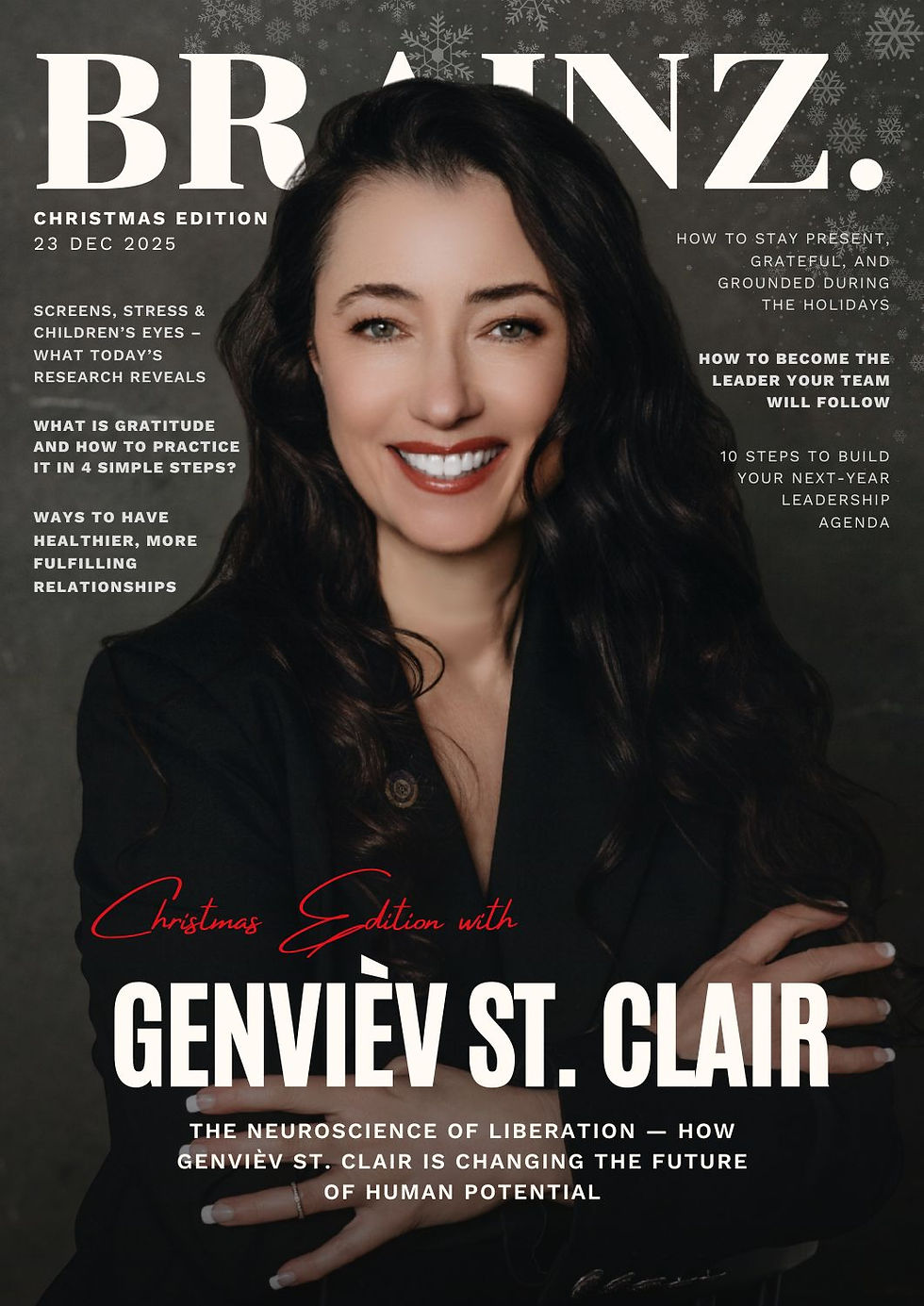Welcome to Mo Chuisle Healing Breath and all things Breathwork
- Brainz Magazine

- May 23, 2025
- 11 min read
Written by Dara Bradley, Breathwork Facilitator & Coach
Dara Bradley, based in Cork Ireland, is the founder of Mo Chuisle Healing Breath, an experiential sanctuary she created to encourage healing and growth through the power of the breath. She has guided hundreds of individuals on their paths to self-discovery and deep transformation through her unique Mo Chuisle Healing Breathwork Journeys.

Welcome to Mo Chuisle Healing Breath, where the power of the breath meets ancient wisdom and modern science to create profound transformation. In this collaboration with Brainz Magazine, Dara shares her lived experience and expertise from over nine years in the holistic and psychological space, guiding you through the origins, science, and deep healing potential of breathwork. Whether you’re new to conscious breathwork or curious to deepen your practice, this is your invitation to reconnect with the most underrated superpower of the human body – your breath!

Origins of breathwork
Breathing has been an essential part of human health and spiritual wellness for thousands of years and has much deeper function, than just survival. The ancients and yogis had all this figured out thousands of years ago, connecting the mind, body and spirit, through ancient Pranayama, Qi Gong and Taoist breathing techniques and meditation practices. But somewhere along the way, we lost a focus on this ancient wisdom and insight, that enables a deep connection to self.
Conscious Connected Breathwork, as we know it today, began to take shape in the 1960s and 1970s with the emergence of two influential methods. The first was Rebirthing Breathwork, developed by Leonard Orr, who discovered that conscious, continuous breathing could unlock emotional blockages and release repressed trauma in the body.
Around the same time, Stanislav Grof, a psychiatrist and researcher of altered states of consciousness, began seeking new therapeutic approaches after LSD (lysergic acid diethylamide) was banned for clinical use in the U.S. He co-developed Holotropic Breathwork with his wife Christina Grof — a method that combines deep, rhythmic breathing, evocative music, and bodywork, designed to access altered states of consciousness, similar to those induced by LSD, to facilitate deep psychological healing.
These pioneering practices, rooted in ancient wisdom, laid the foundations for the modern breathwork movement, inspiring a wide range of breathing techniques used today – from gentle, mindfulness-based practices to deep, cathartic and transformational sessions—all grounded in the simple yet profound power of the breath.
The breath is the most underrated superpower of the human body
Breathwork is changing lives rapidly. It is the practice that has taken the Health and Wellness world by storm because it is instant, it’s effective and it’s free! Breathing is so simple, yet so deep, and we are still only scratching the surface with what is possible with the breath. As the speed of consciousness is growing, more and more people are awakening, healing and turning their focus inwards to discover this raw force inside, that we all have access to!
What breathwork does so effortlessly is reconnect you with your body and your felt experience of life. It helps you step out of your head, quiet the mind chatter we all experience,and reconnect with yourself in a deeper way. It’s a science backed, drug free method that stimulates the release of the body’s natural ’happy chemicals’ – Dopamine, Oxytocin, Serotonin and Endorphins – which can significantly improve how you feel and relate to both yourself and others.
Breathing optimally has a significant impact on both your mental health and fitness. Unfortunately, most of us have never been taught how to breathe properly and have developed unhealthy breathing habits that restrict our natural flow of air. This makes it nearly impossible to feel good, sleep well, or train effectively if your breathing isn’t healthy. The good news is that once you become aware of any unconscious breathing patterns, you can gradually retrain your body and muscles to breathe in a more supportive and effective way.
It can sometimes be overlooked by medical professionals when patients present with varying symptoms like stress, anxiety, low mood, fatigue, poor sleep or digestion.
Unlike pharmaceutical treatments, you can’t charge for a prescription to use the breath, and it doesn’t align with the pharmaceutical agenda! However, there has been a significant shift in recent years, with more doctors and healthcare providers recognising the profound impact that breathing has on our mental and physical well-being, with many now recommending breathwork as an effective tool to bring balance naturally. Ultimately, it empowers and helps people feel better in themselves (some of the many benefits) rather than medication being the first and/or only solution.
Breathwork is increasingly being recognised as an incredible self-care tool to improve students well-being aswell. It warms my heart to see more schools incorporating mindful breathing exercises into their lesson plans and classes. This is a tool they can carry with them for life. I wish I had known about it when I was younger.
Learn young, breathe well, live well
We are facing a societal pandemic of exhaustion, stress, anxiety and burnout, with an increasing number of people seeking mental health support than ever before. However, a quiet but fierce revolution is taking place in our approach to health and well-being, supported by modern science. Many are now turning inward, discovering just how transformative and powerful the breath can be, with benefits that are endless. But more importantly, it’s helping them feel better, restoring balance, safety and regulation back into their bodies.
Our breath is the fastest and the simplest way to regulate how we respond, how we feel and how we experience life.
Big Pharma is not too happy about this revolution. I wonder why!
Benefits of breathwork
Some of the many benefits of Breathwork (depending on which way you use the breath!)
Regulate and tone the nervous system – relax, balance or energise
Increase motivation and concentration
Calm and relax the mind and body
Reduce stress, anxiety & overwhelm
Boost immune system and lung capacity
Improve quality of sleep, rest and digestion
Physical, emotional, psychological and spiritual healing
Gain greater clarity and connect more deeply to your sense of purpose and intuition
A heightened sense of well-being, with more self-acceptance and self-love
Release emotional blockages and trauma
Access deeper states of consciousness and spiritual connection
And many more…

So, what is breathwork?
There are so many different approaches and styles of breathwork that it can be overwhelming at first, and it certainly was for me when I first discovered it.
The word ‘Breathwork’ itself is an umbrella term, much like ‘’Fitness’’, and is used to describe a range of breathing exercises and techniques.
Breathwork can be broken down into 3 main practices, each outlined and described in more detail below:
Breath Awareness (Passive)
Conscious Controlled Breathwork (Pranayama/Functional Breathwork)
Conscious Connected Breathwork (Healing /Therapeutic Breathwork)
Breathwork teaches us how to breathe more effectively and efficiently (Functional breathwork), but it can also serve a deeper purpose and can be a powerful tool for personal growth and healing (Healing/Therapeutic breathwork).
The choice is yours!
Breathwork 101: Breath awareness
We breathe over 25,000 breaths in a single day, yet how often do we actually notice them? The first fundamental practice in breathwork is developing breath awareness. Begin by becoming a witness to your own breath, observing any unconscious breathing patterns you may have developed, which can vary from person to person. Connect with your breath before making any changes to it. This can be done anywhere, at any time.
Being with the breath, allowing it, and accepting it as it is – without judgement – helps you connect to yourself and the present moment, free from external distractions or influences. All your focus turns inwards, toward your felt experience of the breath in the body – its quality, its flow, its speed. Each breathing pattern reflects your thoughts and emotions, and can reveal much about where you are within yourself in any given moment.
Once you bring this awareness to your breath, you can then choose to actively change the pattern, if needed.
Conscious controlled breathwork (functional)
As mentioned above, most modern breathwork techniques have their roots in pranayama, where the breath is actively controlled and shaped with intention – giving it a certain pattern, flow, quality and speed, after the breath awareness practice.
This conscious control of the breath allows you to regulate your nervous system and transition between different states:
Upregulate – to energise the Nervous System –Breathing faster increases alkalinity in the blood (making it slightly less acidic) –Typically involves 20+ breaths per minute.
Balance the Nervous System in any given moment – Inhale and exhale are the same length, with an optimal rhythm of 4–6 breaths per minute.
Downregulate – to calm or relax the nervous system. Slowing the breath and extending the exhale makes the blood slightly more acidic. Fewer than 4 breaths per minute is ideal.
The way you breathe often mirrors the way you live. Are you present and connected, flowing with life? Or are you absent and disconnected, resisting what is? When you calm and slow the breath, the mind tends to follow.
Breathwork is highly effective in optimising your health and fitness using a range of breathing techniques and methodologies to enhance overall well being and sports performance (See Patrick Mc Keown’s Oxygen Advantage) or by using the Buteyko Method, a scientifically proven and extremely effective way to help with asthma, eczema, allergies, high blood pressure, sleep issues, and other health issues. It’s very empowering to play an active role in your own health, fitness, healing and growth.
At its core, breathwork is the practice of consciously influencing the levels of oxygen and carbon dioxide in the body. While oxygen often takes centre stage in conversations about breathing and health, carbon dioxide (CO₂) is frequently overlooked, being dismissed as just a waste gas. In reality, CO₂ plays a far more crucial role than most people realize. The presence of CO₂ in the bloodstream is essential for effective oxygen delivery. According to the Bohr Effect, it is actually the levels of carbon dioxide that help your body release more oxygen from the blood into your cells. And so, it’s not just about how much oxygen you inhale that matters—it’s more about how much carbon dioxide you retain, which determines how efficiently the oxygen already in your blood is delivered to your tissues.
When we breathe too fast — we expel excessive amounts of CO₂ on the exhale. This reduces our body’s ability to absorb oxygen, even when oxygen levels in the blood are high. CO₂ also acts as a natural bronchodilator and vasodilator, helping to keep airways open and blood vessels relaxed. So, when CO₂ levels drop too low, it can lead to constriction in the blood vessels, bronchial passages, and even the digestive tract. This can create a sensation of breathlessness, anxiety or tension, tricking the body into thinking we need to breathe more—when in fact, we need to breathe less! This vicious cycle of over-breathing and CO₂ depletion, can contribute to a variety of physical and mental health challenges.
Functional breathwork helps to break this cycle by rebuilding CO₂ tolerance and restoring balance. Two of the most effective ways to do this is by slowing the breath and gently reducing overall breathing volume, along with incorporating conscious breath-holding practices – both of which help the body adapt to higher levels of carbon dioxide and support more efficient oxygen use.
As the saying goes… ‘’There’s an Oil for that’’
And now you know, there is also a Breath for that!

Conscious connected breathwork (healing)
Conscious Connected Breathwork (CCB) is a safe therapeutic breathing practice, a holistic approach to self-healing which can work on multiple levels – physical, mental, emotional and spiritual. It’s one of the few modalities, alongside plant medicine and hypnosis, that allows access to the subconscious mind and altered states of consciousness through conscious, continuous circular breathing. Unlike plant medicine, however, CCB gives you the freedom to come out of the experience at any time.
In this practice, the breather consciously controls their breath for an extended period (typically between 30 minutes and 1.5 hours), usually breathing in and out through the mouth, just for this period of time. The inhale is connected directly to the exhale, and the exhale back to the inhale, with no pauses in between. This creates an active, circular rhythm with the breath. As a result, blood pH shifts slightly to a more alkaline state due to the increased release of CO₂, often creating various physiological sensations in the body.
The breather remains in control at all times and can slow down the process simply by slowing the breath, switching to nasal inhales, and lengthening the exhale. Each session you do, you will experience it differently depending on what you need and what you are ready to process, at that moment in time. The breath will meet you where you are at and the depth of the experience depends largely on the individual's ability to surrender, trust, and let go.
A full CCB session should be facilitated by a trained and skilled practitioner and may incorporate a wide range of styles — such as Holotropic, Rebirthing, Shamanic, Transformational, Wim Hof Method etc — each offering unique approaches and can vary significantly depending on the facilitator and how the session is delivered (guided or self-led, the specific breathing technique used, music choices, the inclusion of meditations, visualizations, breath holds, mandalas, or themed inner journeys etc).
Using breath in a deep and healing way
Breath is the bridge between the body and the mind. Conscious Connected Breathwork (CCB) is often described as “meditation on steroids” because of its ability to quiet the mind and racing thoughts more quickly than traditional meditation, guiding you into a profound state of stillness and presence—often deeper than anything experienced before.
We each have our own somatic memory and truth. Our body is like an archive of all the experiences we have ever been through, the body remembers everything that the mind forgets, and if unprocessed, this energy gets stored in our cells, in our biological makeup. Any overwhelming experience that does not get digested or felt in the moment – lodges in the nervous system and can get stuck in parts of the body as some form of tension or unease. Overtime, the longer it is stored and unaddressed or ’unfelt’, it affects the physical tissues and can cause ‘dis-ease’ in the body.
Breathwork offers a way to dissolve these tensions at the nervous system level. It helps release trapped energy—physically and energetically—creating more space in the body, mind, heart, and soul. It is a powerful and embodied practice for working with anxiety, stress, emotional tension, and trauma.
For some, the breathwork journey becomes a gateway to profound spiritual experiences. As the breath creates a sacred rhythm, it can dissolve the veil between worlds. In these altered states, many feel the loving presence of those who have passed—not gone, but transformed into an energetic form, vibrating at a different frequency. These moments can bring deep comfort and soul-level healing.
‘’The answers you seek are within’’ we already know, we already hold the answers, ones that are unique to our own individual journeys. We are not separate from truth, we are connected to it through our intuition, experiences, memories, beliefs, values, and self-awareness. By looking inward- through stillness, reflection, meditation, breathwork or whatever practice works for you, we can discover our authentic path and the answers that are right for us.
There is no expert on YOU better than yourself!
I’ll be sharing more delicious and in-depth insights on all this in my upcoming articles, but this is the core of what breathwork is all about. If it resonates with you and you feel called to, consider giving it a try!
Just Breathe
My Darling, Mo Chuisle
Interested in exploring breathwork?
Join Dara for an upcoming in-person breathwork journey across Ireland here or connect from anywhere in the world through a 1:1 online breathwork session.
To contact her, please email dara@mochuislehealingbreath.com
Read more from Dara Bradley
Dara Bradley, Breathwork Facilitator & Coach
Dara Bradley, based in Cork Ireland, is an experienced and multi-certified Breathwork Facilitator & Breathwork Coach, complimented with an academic background in psychology. She has spent years deeply immersed in the study of the mind & body relationship, allowing her to integrate scientific understanding with holistic somatic practices and therapeutic breathwork experiences.
Dara first discovered breathwork during the height of the COVID pandemic, at a particularly stressful time in her life—and it completely transformed her world. From her very first experience, she knew she had stumbled upon something profoundly powerful: a self-care tool that’s available to all of us—our own breath. She was amazed by its impact and equally puzzled that so few people seemed to know about it.
Driven by a deep inner calling, she made the bold decision to leave her 'safe and pensionable' corporate career of 16 years to pursue this newfound purpose. In 2022, she founded Mo Chuisle Healing Breath—and the rest, as they say, is history.










.jpg)